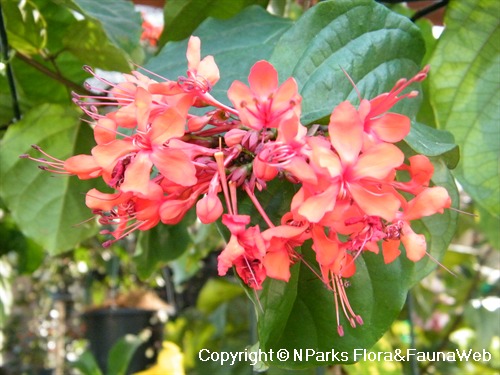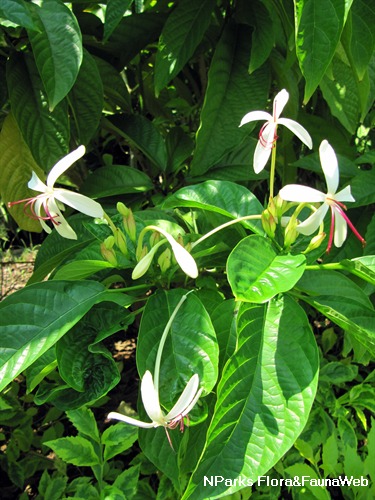
Name
Classifications and Characteristics
| Plant Division | Angiosperms (Flowering Seed Plants) |
|---|---|
| Plant Growth Form | Shrub, Tree (Small (6m-15m)) |
| Lifespan (in Singapore) | Perennial |
| Mode of Nutrition | Autotrophic |
| Plant Shape | Irregular |
| Maximum Height | 7.5 m |
Biogeography
| Native Distribution | India to Myanmar, Indochina, Thailand, Sumatra, Peninsular Malaysia, Singapore, the Philippines, Borneo, and Java |
|---|---|
| Native Habitat | Terrestrial (Primary Rainforest, Secondary Rainforest, Freshwater Swamp Forest, Grassland / Savannah/ Scrubland, Disturbed Area / Open Ground) |
| Preferred Climate Zone | Tropical |
| Local Conservation Status | Native to Singapore (Least Concern (LC)) |
Description and Ethnobotany
| Growth Form | It is a shrub or small tree up to 7.5 m tall and entirely covered with soft, often thick velvety, white hairs. |
|---|---|
| Foliage | Its opposite, stalked leaves possess leaf blades that are light green, mostly heart-shaped, and 7–29 by 5–21 cm, with short tips. |
| Flowers | Its flowering clusters, at the branch tips, are shoots up to 31 cm long and wide, bearing white, 1.3 cm-wide flowers. |
| Fruit | Its black fruits are round and 8–10 mm wide. The fruits are seated on a fleshy, star-like, white, cup-like structure formed by the persistent calyx. |
| Habitat | It grows along forest margins, in open countries, villages, and waste places, up to 900 m altitude. |
| Associated Fauna | Its flowers are insect-pollinated and its fruits are eaten by birds. |
| Cultivation | It can be propagated by seed. |
| Etymology | Greek kleros, chance; Greek dendron, a tree, referring to the variable medicinal efficacies of the plants in this genus; Latin villosum, covered with soft hair, referring to the hair found on this plant |
Landscaping Features
| Landscaping | This species can be grown in parks and gardens as a shrub and may be tolerant of roadside conditions. The whitish appearance of the plant from its hairs, the large inflorescences, and shiny black fruits, make it distinctive and attractive. |
|---|---|
| Desirable Plant Features | Ornamental Flowers, Ornamental Foliage, Ornamental Fruits |
| Landscape Uses | General, Suitable for Roadsides, Parks & Gardens, Small Gardens |
| Thematic Landscaping | Silver Garden |
Fauna, Pollination and Dispersal
| Fauna Pollination Dispersal Associated Fauna | Bird-Attracting, Butterfly-Attracting |
|---|---|
| Pollination Method(s) | Biotic (Fauna) |
| Seed or Spore Dispersal | Biotic (Fauna) |
Plant Care and Propagation
| Light Preference | Full Sun |
|---|---|
| Water Preference | Moderate Water |
| Plant Growth Rate | Moderate |
| Rootzone Tolerance | Moist Soils, Well-Drained Soils, Fertile Loamy Soils |
| Propagation Method | Seed |
Foliar
| Foliage Retention | Evergreen |
|---|---|
| Mature Foliage Colour(s) | Green, Green - Light Green, Silver / Grey |
| Mature Foliage Texture(s) | Velvety / Furry / Tomentose |
| Foliar Type | Simple / Unifoliate |
| Foliar Arrangement Along Stem | Opposite |
| Foliar Attachment to Stem | Petiolate |
| Foliar Shape(s) | Non-Palm Foliage (Cordate) |
| Foliar Venation | Pinnate / Net |
| Foliar Margin | Entire |
| Leaf Area Index (LAI) for Green Plot Ratio | 4.5 (Shrub & Groundcover - Dicot) |
Floral (Angiosperm)
| Flower & Plant Sexuality | Bisexual Flowers |
| Flower Colour(s) | White |
|---|---|
| Flower Grouping | Cluster / Inflorescence |
| Flower Location | Terminal |
| Flower Symmetry | Bilateral |
Fruit, Seed and Spore
| Mature Fruit Colour(s) | Black |
|---|---|
| Fruit Classification | Simple Fruit |
| Fruit Type | Fleshy Fruit , Non-Accessory Fruit |
Image Repository
Others
| Master ID | 534 |
|---|---|
| Species ID | 1830 |
| Flora Disclaimer | The information in this website has been compiled from reliable sources, such as reference works on medicinal plants. It is not a substitute for medical advice or treatment and NParks does not purport to provide any medical advice. Readers should always consult his/her physician before using or consuming a plant for medicinal purposes. |












